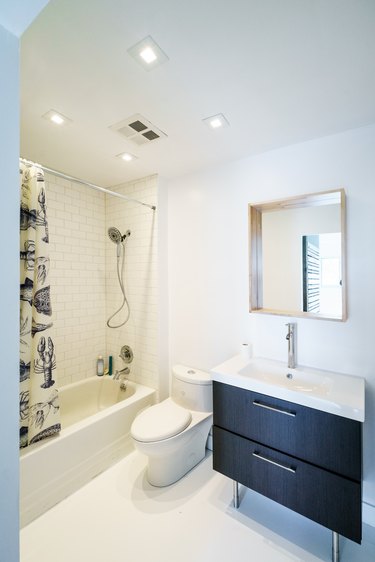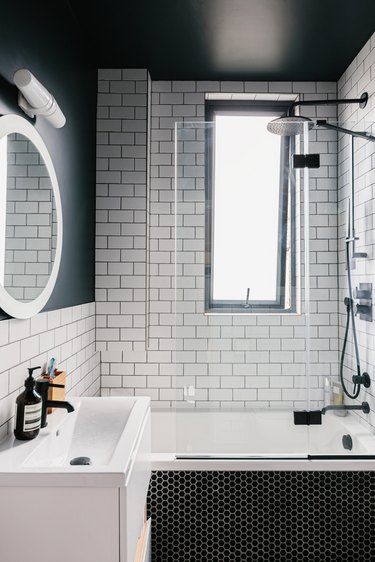There are some important considerations that need to be addressed in order to solve a mold problem on a bathroom ceiling, which will need to be tackled before it can be repainted. The issues include understanding the cause of the mold and treating it as well as preparing the surface to accept paint. If the mold isn't handled correctly, it will simply return again and again.
Mold is a spore that is considered to be a fungus. It comes in a variety of different colors, such as orange, green and even black mold, all of which can give you allergy issues or even cause severe respiratory symptoms such as shortness of breath. Most often, homeowners will spot some mold on the ceiling before it becomes widespread, and it should be treated as quickly as possible once it is identified. Once established, it is possible for mold to spread, making it harder to eliminate.
Video of the Day
Video of the Day
How a Mold Problem Develops
Mold is found most often in areas that are damp or moist and in spots that have poor air circulation. Since humidity is the big driver for mold, bathrooms are a likely place for it to develop. Because showers, sinks and bathtubs all contribute to moisture in the air, it makes sense that mold can get a foothold on the ceiling in a bathroom. Once discovered, it's critical to identify the cause of the bathroom mold and address it before repainting the area. If this isn't done, the problem will remain. Mold can come back easily, even right through new paint.
All mold problems are moisture problems, so start troubleshooting by looking at different scenarios. If the bathroom is under a roof area, check to see if there may be a leak causing the problem. One way to tell is if the area drips when it rains. If so, the leak can be patched so the water stops intruding on the ceiling. Plumbing leaks are another possibility, so watch for dripping when water is being run in the house. If there doesn't seem to be a regular drip in the area, you most likely have a humidity problem to address rather than a leak.
Many times, just the humidity from showers is enough to give mold a foothold. You can take care of this by installing a vent fan in the bathroom if there isn't one there already. If an exhaust fan is present, make sure it's ducted to the outdoors and that it's powerful enough for the room. If not, it can be swapped for a more appropriate model. The Home Ventilating Institute offers general guidelines, with average-sized bathrooms between 50 and 100 square feet needing minimum ventilation of 1 cubic feet per minute per square foot of floor space.

Basic DIY Mold Removal
It is important to completely remove as much of the mold as possible before treating the area for paint. Unless the mold spans a large area, this can easily be a DIY project since it isn't too difficult to kill mold. If the moldy area is less than a 3 x 3-foot patch, the Environmental Protection Agency says that a mold remediation expert isn't usually needed. It recommends wearing a respirator, gloves and eye protection as well as old clothing that can be tossed afterward. In addition, those with allergies to mold will probably want to have someone else do the cleaning.
Fill a spray bottle with three parts water and one part bleach. Spray this mixture onto the moldy area of the ceiling and let it soak in for a few minutes. Depending on the amount of mold growth, use either a cloth or a scrub brush to wipe off as much of the mold as possible. This may need to be done again for areas that still have a lot of mold left. Bleach is a strong scent, so make sure to open doors and windows to ventilate.
Borax is another substance that can be used to combat mold growth. Mix a cup of it in a bucket of hot water and scrub the ceiling until it is clean. Since killing every one of the mold spores isn't likely, it's important to be thorough so as much as possible is removed. For either method, be sure to let the ceiling area dry completely before taking any additional steps toward painting.

Priming and Painting the Bathroom Ceiling
Once the mold problem has been dealt with and the ceiling dries, there are other steps needed prior to painting. Usually, a moldy ceiling means there's a stained area that must be covered up properly before paint can be applied. Use a primer to take care of this issue so that the paint will match the other areas of the ceiling. Brands such as Zinsser Mold Killing Primer or Kilz Mold & Mildew have the primary function of acting as a stain blocker and work well for a bathroom ceiling area.
Be sure to let the primer dry thoroughly and then reassess the ceiling to see if the stain is fully covered. If not, it may take another coat to make sure everything looks good. Although it may be tempting to try and touch up just the one area with paint, the best way to ensure a seamless job is to repaint the entire ceiling. Also keep in mind that some paints are better suited for bathroom ceilings than others.
Regardless of what type of paint was on the ceiling previously, once mold has appeared, it pays to re-evaluate what will be used to repaint the area. Generally speaking, flat paints let more moisture through than eggshell paints, and satin or semigloss paints are even more moisture-resistant. That said, the glossier the paint, the more difficult it is to make it look good. For best results, try to balance the decision based on the amount of moisture resistance in the paint and the skill level of the person who is painting the ceiling. Opt for an eggshell or satin for a good middle-ground paint that will help block moisture and will go on fairly easily.
Preventing Future Mold Buildup
In order to keep a bathroom ceiling free of mold, it's a smart idea to try to minimize any moisture that lingers in the room. The best way to do that is by using the vent fan properly. Bathroom vents should be on whenever someone is taking a shower and left to run for 15 to 20 minutes once the shower is finished. This will pull a lot of the moisture out of the air instead of letting it linger. Both dehumidifiers and air conditioners can also help with moisture management.
Other small steps can reduce overall moisture in the bathroom. Glass shower doors can be squeegeed, and tile can be wiped down with a soft towel. Leaving the bathroom door open after a shower will also help. The less water that is left in the room, the lower the chances that mold and mildew will get a foothold.
